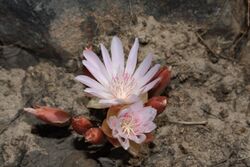Biology:Bitterroot
| Bitterroot | |
|---|---|

| |
| Lewisia rediviva var. rediviva in Wenas Wildlife Area, Washington (state) | |
| Scientific classification | |
| Kingdom: | Plantae |
| Clade: | Tracheophytes |
| Clade: | Angiosperms |
| Clade: | Eudicots |
| Order: | Caryophyllales |
| Family: | Montiaceae |
| Genus: | Lewisia |
| Species: | L. rediviva
|
| Binomial name | |
| Lewisia rediviva | |
Bitterroot (Lewisia rediviva) is a small perennial herb in the family Montiaceae. Its specific epithet rediviva ("revived, reborn") refers to its ability to regenerate from dry and seemingly dead roots.[1]
The genus Lewisia was moved in 2009 from the purslane family (Portulacaceae) with adoption of the APG III system, which established the family Montiaceae.
Description
Lewisia rediviva is a low-growing perennial plant with a fleshy taproot and a simple or branched base and a low rosette of thick fleshy linear leaves with blunt tips. The leaves are roughly circular in cross section, sometimes somewhat flattened on the adaxial (top) surface. The absence of an adaxial groove on the leaves distinguishes this from other Lewisia species with overlapping ranges. The leaves often wither before flowers open.
The very short flower stems are leafless, 1–3 centimetres (3⁄8–1 1⁄8 in) tall, bearing at the tip a whorl of 5–6 linear bracts which are 5–10 mm long. A single proportionally huge flower appears on each stem with 5–9 oval-shaped sepals and many petals.[2] The petals (usually about 15) are oblong in shape and are 18–35 millimetres (3⁄4–1 3⁄8 in) long.[2] They range in color from whitish to deep pink or lavender. Flowering occurs from April through July.[3] At maturity, the bitterroot produces egg-shaped capsules with 6–20 nearly round seeds.[2]
Distribution
The plant is native to western North America from low to moderate elevations on grassland, open bushland, forest in dry rocky or gravelly soils. Its range extends from southern British Columbia, through Washington (state) and Oregon west of the Cascade Range to southern California , and east to western Montana, Wyoming, northern Colorado and northern Arizona.[3][4][2][5]
Uses
The thick roots come into season in spring[6] and can survive extremely dry conditions. If collected early enough in the season,[7] they can be peeled, boiled, and made into a jelly-like food.[6]
History and culture
French trappers knew the plant as racine amère (bitter root).[8] Native American names include spetlum/sp̓eƛ̓m̓ or spetlem ("hand-peeled"), nakamtcu (Ktanxa: naqam¢u),[9] and mo'ôtáa-heséeo'ôtse (Cheyenne, "black medicine").Cite error: Closing </ref> missing for <ref> tag The Lemhi Shoshone believed the small red core found in the upper taproot had special powers, notably being able to stop a bear attack.[8] Plains Indians peeled and boiled the root prior to its consumption.[7]
Meriwether Lewis ate bitterroot in 1805 and 1806 during the Lewis and Clark Expedition. The specimens he brought back were identified and given their scientific name, Lewisia rediviva, by a German-American botanist, Frederick Pursh.[8] Based on Lewis and Clark's manuscript, Pursh labeled it "spatlum"; this apparently was actually a Salishan name for "tobacco".[10]
The bitterroot was selected as the Montana state flower in 1895.[11]
Three major geographic features – the Bitterroot Mountains (running north–south and forming the divide between Idaho and Montana), the Bitterroot Valley, and the Bitterroot River (which flows south–north, terminating in the Clark Fork river in the city of Missoula) – owe the origins of their names to this flower.[8][12]
References
- ↑ William Curtis (1801). The Curtis's botanical magazine. p. 123. https://archive.org/stream/mobot31753002721634#page/n122/mode/2up/search/pursh. "The specific name rediviva is given by Pursh in consequence of the root, long preserved in the herbarium, and apparently dead, having been planted, revived in a garden in Philadelphia."
- ↑ 2.0 2.1 2.2 2.3 Klinkenberg, Brian, ed (2014). "Lewisia rediviva". Lab for Advanced Spatial Analysis, Department of Geography, University of British Columbia, Vancouver. http://linnet.geog.ubc.ca/Atlas/Atlas.aspx?sciname=Lewisia%20rediviva.
- ↑ 3.0 3.1 Sullivan, Steven. K. (2015). "Lewisia rediviva". http://www.wildflowersearch.com/search?&PlantName=Lewisia+rediviva.
- ↑ "Lewisia rediviva". United States Department of Agriculture; Natural Resources Conservation Service. 2015. http://plants.usda.gov/java/profile?symbol=LERE7.
- ↑ Giblin, David, ed (2015). "Lewisia rediviva". Burke Museum, University of Washington. http://biology.burke.washington.edu/herbarium/imagecollection.php?Genus=Lewisia&Species=rediviva.
- ↑ 6.0 6.1 Angier, Bradford (1974). Field Guide to Edible Wild Plants. Harrisburg, PA: Stackpole Books. pp. 36. ISBN 0-8117-0616-8. OCLC 799792. https://archive.org/details/fieldguidetoedib00angi/page/36/mode/2up.
- ↑ 7.0 7.1 Taylor, Ronald J. (1994) (in en). Sagebrush Country: A Wildflower Sanctuary (rev. ed.). Missoula, MT: Mountain Press Pub. Co. pp. 122. ISBN 0-87842-280-3. OCLC 25708726. https://www.worldcat.org/oclc/25708726.
- ↑ 8.0 8.1 8.2 8.3 "Trivia | BitterrootHeaven.com". http://bitterrootheaven.com/trivia.html.
- ↑ "FirstVoices: Ktunaxa words". http://www.firstvoices.ca/en/Ktunaxa/word/63b51dec5cf5793e/Bitterroot.
- ↑ Bureau of American Ethnology (1910). Handbook of American Indians. p. 624. https://books.google.com/books?id=hZAUwZk4vgcC. "its supposed name was obtained from Lewis's manuscript by Pursh, who gives it as spatlum (Spatlum Aboriginorum). The name, which is Salishan, is here a misapplication, since spatlûm in the Comox dialect (spätlûm in the Kwantlin) is the name for"
- ↑ Montana. Dept. of Public Instruction (1929). Montana Educational Directory. p. 30. https://archive.org/stream/montanaeducation00mont_5#page/30/mode/1up/search/flower. "The Montana state flower, adopted by act of the Legislative Assembly, approved February 27, 1895, is the Bitter Root (Lewisia rediviva)."
- ↑ US Forest Service (1909). Names of National Forests with Their Origin, Definition, Or Derivation. Washington. https://books.google.com/books?id=pas7AQAAMAAJ. "From the plant Lewisia rediviva, which gives name to the Bitter Root mountains and river of Montana and Idaho."
Further reading
- Johnny Arlee (2008). The Gift of the Bitterroot. Salish Kootenai College, Npustin Press. ISBN 9780981683416. https://www.lessonsofourland.org/wp-content/uploads/2017/08/Gift-of-the-Bitterroot.pdf. Retrieved 2018-01-24.
- Moerman. D. Native American Ethnobotany. Timber Press. Oregon. 1998 ISBN:0-88192-453-9
External links
- Calflora Database: Lewisia rediviva (Bitter root)
- Central Washington Native Plant Society
- Plants of the Lewis and Clark Expedition
- Bitterroot, Lewis and Clark National Historic Trail, U.S. Forest Service
- WSDOT - Ethnobotany - Herbs. Lewisia rediviva - Bitter-root, Sand Rose, Portulacaceae (Purslane Family)
Wikidata ☰ Q4113860 entry
 |




